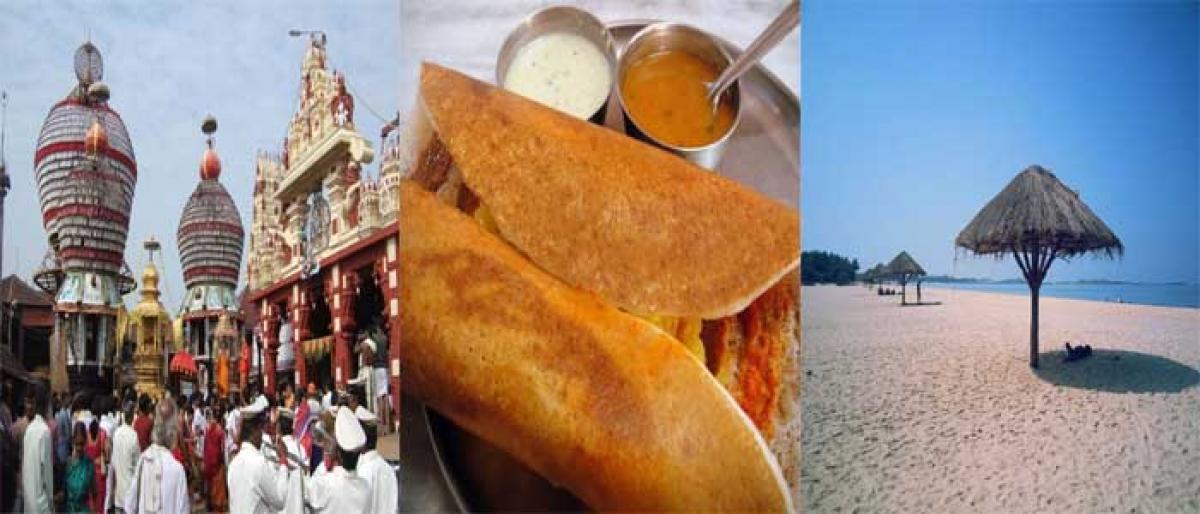Temple town of Karnataka

My earliest memory of Udupi is from my childhood days and the memory is of its iconic food, the masala dosa. We had stopped at a small eatery in Udupi after a long drive and my father ordered the masala dosa on the insistence of the waiters and manager. This is actually a common occurrence – almost everyone who enters a restaurant here will be no doubt given the full menu but will be urged to orde
Udupi is popular for its vegetarian cuisine across the country. However, this place also boasts of famous pilgrim spots like Krishna temple, Anegudde Vinayaka temple, Chandramoulishwara temple, Lakshmi-Venkateswara temple, Ananteshwara temple among others
My earliest memory of Udupi is from my childhood days and the memory is of its iconic food, the masala dosa. We had stopped at a small eatery in Udupi after a long drive and my father ordered the masala dosa on the insistence of the waiters and manager. This is actually a common occurrence – almost everyone who enters a restaurant here will be no doubt given the full menu but will be urged to order the masala dosa to eat or at least taste.
The dosa and in fact an entire range of vegetarian cuisine are the pride of Udupi. As is its famous Krishna temple, of course, which I was visiting again with cousins recently. The Krishna temple is a huge complex. In fact, the entire city is dotted with small temples as well as bigger ones like the Anegudde Vinayaka temple, Chandramoulishwara temple, Lakshmi-Venkateswara temple, Ananteshwara temple, etc.
Udupi city is about 60 km from Mangalore in the state of Karnataka. It is also referred to as Odipu or Udipi. Here, the Udupi Sri Krishna temple and the Krishna Matha draw lakhs of pilgrims every year. The Krishna Matha was founded by the Vaishnavite saint and founder-proponent of Dwaithism or Dwaitha Siddhantha (duality) Jagadguru Shri Madhwacharya in the 13th century.
The architecture and sculptures of the Krishna temple impress with their aesthetic beauty. The enormous temple chariot is a must-see. The presiding deity here, Krishna is in the form of a child or Bala-Krishna holding a churner. A small window with nine holes covers the immediate front of the Krishna idol and is called Navagraha Kindi.
The devout see and worship the Lord through this window. There is another window called Kanakana Kindi which, according to legend was created by the God himself to enable darshan to the devotee Kanakadasa who was being denied entry because of his caste. The story goes that the idol even turned round to facilitate darshan by Kanakadasa.
The everyday activities and sevas to the presiding deity as well as the administration of the Krishna Matha are managed by the Ashta Mathas or eight Mutts or monasteries. Following a cyclical order, each Matha is entrusted with temple management activities for two years.
These Mathas have a set of traditions and customs which are laid down and strictly enforced. The Krishna Matha is known as a centre of Dvaitha philosophy and Daasa Sahithya, a form of devotional literature. Interestingly, Palamoor in Mahboobnagar in Telangana is where Shri Satyatma Teertha Swamiji, the present pontiff of the Uttaradi Matha from Udupi, spent his Chaturmasya Deeksha period this year.
After darshan, we had lunch at the temple – food is served free of cost to all visiting pilgrims. It was a big spread and the most delicious meal of our trip served with love and humility. Whether it is the Krishna temple food or the pure vegetarian cuisine to which Udupi has given its name, they are both justly renowned.
It is widely believed that the masala dosa was invented in Udupi. South India and many parts of the North too, are dotted with these Udupi aka Udipi restaurants, which are synonymous with authentic, pure vegetarian, south Indian fare. Now, they are seen in a few foreign countries too.
The priest at the Krishna temple told us that many factors contributed to the evolution of this cuisine. He explained: "The origin and growth of this cuisine is intrinsically linked to the Krishna Matha. The naivedyam (sanctified food) offered to Lord Krishna is of different varieties every day. The need for variety, the local produce, the conditions of Vaishnavite cooking and restrictions on ingredients during Chaturmasya period, etc, contributed." We learnt later that Shivalli Madhwa Brahmins developed this cuisine.
All our subsequent meals were at well-known Udipi eateries in the town like the renowned Mitra Samaj for example.
The following day, we took time off to see the Holy Rosary Church, which has a superb location on the Panchagagavli river and then made our way to the lesser-known but very interesting Coin Museum.
Next on our list were the two beaches close to Udupi – Kaup aka Kapu and Malpe. The beach at Kaup is picturesque and its old lighthouse (built in the 1930s) adds to the tourist draw. We shot plenty of pictures here before we moved on to the next beach. Malpe beach was crowded with vacationers and plenty of day-trippers from Udupi especially Manipal.
The shallow waters make it one of the safest beaches in the state. So, even non-swimmers can venture safely into the waters here. Fishing is big here and we saw piles of fishing nets and even met and chatted with a few fishermen.
From Malpe beach, there are boat rides on offer to the nearby St Mary's Island with its vertical basalt rock formations. However, it was close to evening and we had a night train to catch for our return journey so we refused the ride, took the last few pictures and hurried to the hotel and then to the railway station.














